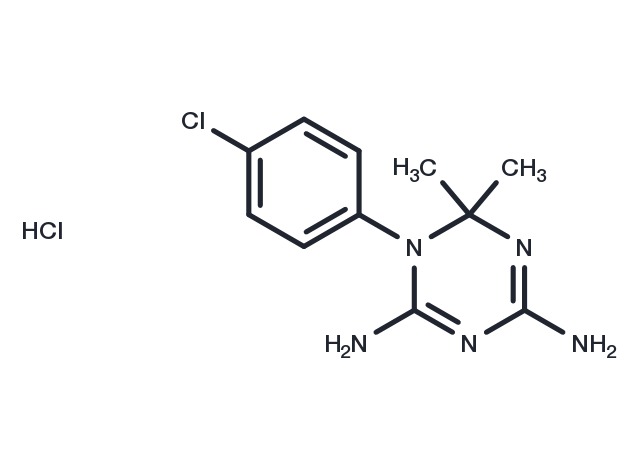Powder: -20°C for 3 years | In solvent: -80°C for 1 year


Cycloguanil hydrochloride (Chloroguanide Triazine) is an active metabolite of the antimalarial compound proguanil. It acts as an inhibitor of dihydrofolate reductase (Kis: 0.3 and 1.5 nM for Plasmodium and human forms, respectively).

| Pack Size | Availability | Price/USD | Quantity |
|---|---|---|---|
| 1 mg | In stock | $ 36.00 | |
| 2 mg | In stock | $ 51.00 | |
| 5 mg | In stock | $ 77.00 | |
| 10 mg | In stock | $ 126.00 | |
| 25 mg | In stock | $ 207.00 | |
| 50 mg | In stock | $ 369.00 | |
| 100 mg | In stock | $ 549.00 | |
| 1 mL * 10 mM (in DMSO) | In stock | $ 119.00 |


| Description | Cycloguanil hydrochloride (Chloroguanide Triazine) is an active metabolite of the antimalarial compound proguanil. It acts as an inhibitor of dihydrofolate reductase (Kis: 0.3 and 1.5 nM for Plasmodium and human forms, respectively). |
| Synonyms | Chloroguanide Triazine |
| Molecular Weight | 288.18 |
| Formula | C11H14ClN5.ClH |
| CAS No. | 152-53-4 |
Powder: -20°C for 3 years | In solvent: -80°C for 1 year
DMSO: 20 mg/mL (69.4 mM)
H2O: 5 mg/mL (17.35 mM)
You can also refer to dose conversion for different animals. More
bottom
Please see Inhibitor Handling Instructions for more frequently ask questions. Topics include: how to prepare stock solutions, how to store products, and cautions on cell-based assays & animal experiments, etc.
Cycloguanil hydrochloride 152-53-4 Metabolism Microbiology/Virology Drug Metabolite Parasite Cycloguanil Inhibitor Chloroguanide Triazine Cycloguanil Hydrochloride inhibit inhibitor
